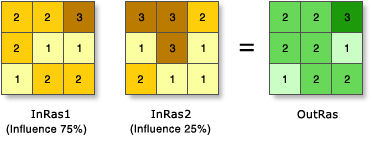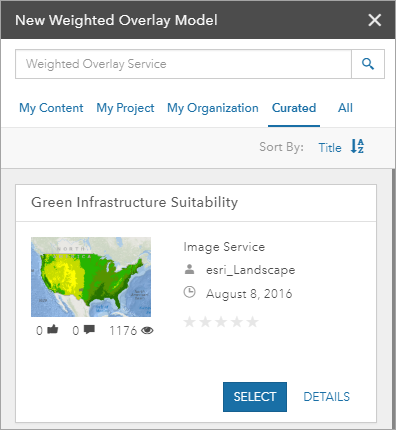Weighted overlay is a type of suitability analysis that helps you analyze site conditions based on multiple criteria. Weighted overlay analysis allows you to combine, weight, and rank several different types of information and visualize it so you can evaluate multiple factors at once. By identifying and rating areas based on criteria, you can discover opportunities, risks, and constraints in an area. Weighted overlay analysis produces suitability models. Suitability models help answer questions such as the following:
- Where are the greatest risks for insect damage?
- Where are optimal locations for a commercial development?
Weighted overlay with ArcGIS GeoPlanner leverages a specific type of image layer known as a weighted overlay service. These services are published to ArcGIS Server and you can add them as items to your ArcGIS organization. There are several weighted overlay services provided by Esri and available publicly in ArcGIS Enterprise. The suitability models created by the GeoPlanner weighted overlay widget are hosted image service layers. These are referred to as weighted overlay model services, or models.
Understanding weighted overlay
Weighted overlay has three conceptual steps. First, each raster layer is assigned a weight, as a percentage, in the analysis. This allows you to emphasize the relative importance of each layer in the analysis. Second, values in each raster layer are mapped to a common suitability scale. This allows you to compare the different types of information in each raster layer. Third, all raster layers in the analysis are overlaid. Each raster cell’s suitability value is multiplied by its layer weight and totaled with the values of other raster cells it overlays. The result is a suitability value that is used for symbology in the output raster layer.

Add Esri–curated services to your organization
Currently, Esri curates two publicly available weighted overlay services that you can add as items to your organization. Complete the following steps to add these weighted overlay services as items to your organization:
- Sign in to your ArcGIS organization with an account that has privileges to create content.
- Click the Content tab and ensure that the My Content tab on the secondary navigation bar is active.
- Click New Item.
The New item dialog box appears with various options for new items.
- Choose the URL option.
- In the URL text box, type https://utility.arcgis.com/usrsvcs/servers/24b7c7752170431a95719323a9e71a5e/rest/services/WRO_World_Ecophysiographic_Data/ImageServer and press the Enter or Tab key.
The service's information is retrieved and ArcGIS Server web service is automatically chosen from the Type drop-down options.
- Click Next.
The Title text box is automatically populated with WRO_World_Ecophysiographic_Data and a folder is automatically specified from the Folder drop-down options.
- In the Tags text box, type weightedOverlayService.
If the weightedOverlayService tag is not included, the service does not appear as an option in GeoPlanner.
- Optionally, provide a summary about the service in the Summary text box.
- Click Save.
- On the item's page, click Share.
The Share dialog box appears.
- On the Share dialog box, choose one of the sharing level options.
Optionally, you can also share the service with a specific group by clicking Edit group sharing in the Set group sharing section of the Share dialog box..
- Click Save.
- Repeat the steps but use https://greeninfrastructuremapsdev.arcgis.com/arcgis/rest/services/GreenInfrastructure/WeightedOverlay_Geoplanner/ImageServer for the URL to add the other publicly available weighted overlay service that is available from Esri.
Note:
This service is a secure URL. You must provide valid Enterprise credentials to add it as an item to your organization and use it for analysis in GeoPlanner.
Weighted overlay in GeoPlanner
Weighted overlay in GeoPlanner is accessed through the Modeler tool in the Explore tab. The Modeler tool drop-down options allow you to create a model or load an existing weighted overlay model from the Contents pane. If you choose to create a model, a weighted overlay service browser appears. This browser contains a list of all weighted overlay services available to you in your ArcGIS organization. These services contain layers that you use to perform weighted overlay analysis.

Complete the following steps to perform a weighted overlay analysis:
- Click the Explore tab in the app and click Modeler.
- From the drop-down menu, choose New Model.
- In the New Weighted Overlay Model widget, scroll the list of services. Click Select on the service you want to use for your weighted overlay analysis.
- Scroll down the list of layers and check the layers you want to include in your analysis. You can choose up to 15 layers.
- Click Design Model.
- Assign each layer a relative importance in the analysis by typing a percentage in the % text box.
The total percentage must equal 100 before you can run the analysis.
- Optionally, click a layer to expand it and adjust its class weights.
Class weights are values in the layer that are mapped to a suitability scale. For example, the Distance to Water layer has a class weight of 0–1609 and is mapped to suitability value 9. This means that any values of 0–1609 in the Distance to Water layer are treated as 9 (high) in the analysis. How you interpret this depends on your criteria. If you are trying to identify areas at risk for flooding, a value of 9 signifies that an area is highly likely to flood. However, if you are trying to site a new housing development, a value of 9 can signify a highly suitable area.
- Optionally, change the color scheme of your design model by clicking the drop-down arrow and choosing a color scheme.
- Click Save.
- On the Save Model dialog box, provide a name for your model in the Title text box and click Save.
Optionally, provide additional details in the Summary and Description text boxes. The Tags text box contains the weightedOverlayModel tag, but you can add others.
The Save Model dialog box closes. The model is processed in your ArcGIS organization and is returned as an image layer to the app.
Weighted overlay models provide a powerful way to visualize and analyze site suitability factors. Based on the shading in your model, you can identify areas of opportunity and risk, and you can use this information for real–time feedback in GeoPlanner dashboard charts. These charts show how your design or other feature layers overlay with assessment layers. This view can help you understand the suitability or risk in your designs and plans.